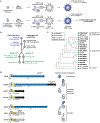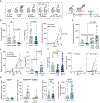Engineered skin bacteria induce antitumor T cell responses against melanoma
- PMID: 37053311
- PMCID: PMC12356174
- DOI: 10.1126/science.abp9563
Engineered skin bacteria induce antitumor T cell responses against melanoma
Abstract
Certain bacterial colonists induce a highly specific T cell response. A hallmark of this encounter is that adaptive immunity develops preemptively, in the absence of an infection. However, the functional properties of colonist-induced T cells are not well defined, limiting our ability to understand anticommensal immunity and harness it therapeutically. We addressed both challenges by engineering the skin bacterium Staphylococcus epidermidis to express tumor antigens anchored to secreted or cell-surface proteins. Upon colonization, engineered S. epidermidis elicits tumor-specific T cells that circulate, infiltrate local and metastatic lesions, and exert cytotoxic activity. Thus, the immune response to a skin colonist can promote cellular immunity at a distal site and can be redirected against a target of therapeutic interest by expressing a target-derived antigen in a commensal.
Figures




Comment in
-
Prevention and treatment of cancers by tumor antigen-expressing Staphylococcus epidermidis.Oncoimmunology. 2023 May 15;12(1):2212547. doi: 10.1080/2162402X.2023.2212547. eCollection 2023. Oncoimmunology. 2023. PMID: 37205984 Free PMC article.
References
MeSH terms
Substances
Grants and funding
LinkOut - more resources
Full Text Sources
Medical

